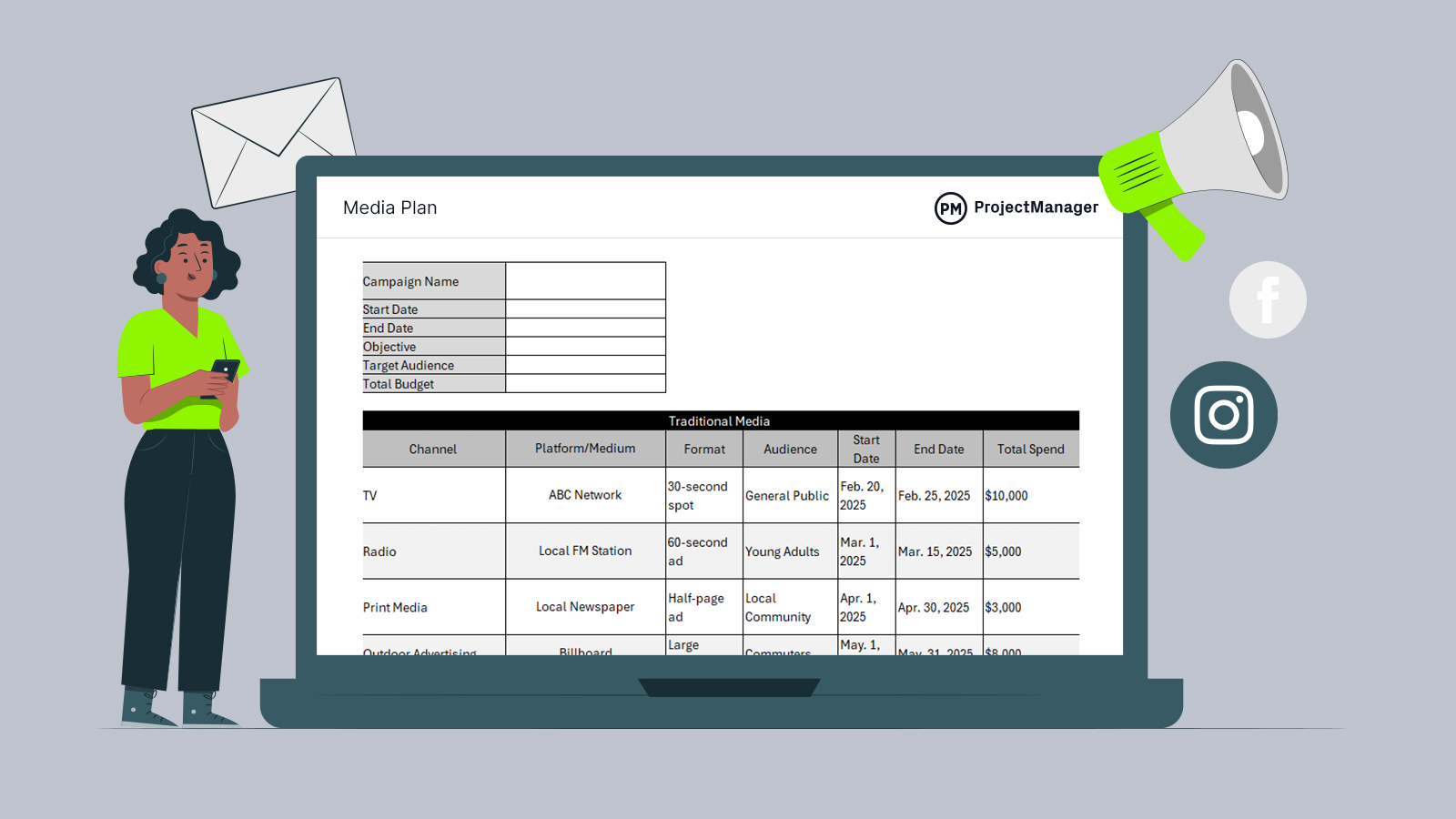When a company is looking to create a marketing campaign for a project or service, they first need to figure out how and where they’re going to advertise. This is where our free marketing plan template for Excel comes in handy. It provides an outline of the media plan, budget, results and metrics to not only plan but also track the marketing push’s success. Download this free media plan template today and get started on the right foot.
What Is a Media Plan Template?
A media plan is a strategic document that outlines how a company will distribute its advertising messages across various media channels to achieve specific marketing objectives. It details how the business will allocate its budget, what platforms or channels will be used and when and how the advertisements will run.
A media plan helps ensure that a business’s advertising efforts are efficient, well-targeted and aligned with the overall marketing strategy. It does this by including campaign objectives and identifying the target audience and media channels or platforms on which the advertising will be placed. A budget is also considered, as well as a timeline for distribution and key performance indicators (KPIs) to judge the campaign’s effectiveness.
A media plan helps businesses optimize their advertising spend and improve the efficiency of marketing efforts, ensuring ads reach the right audience at the right time with the right message.
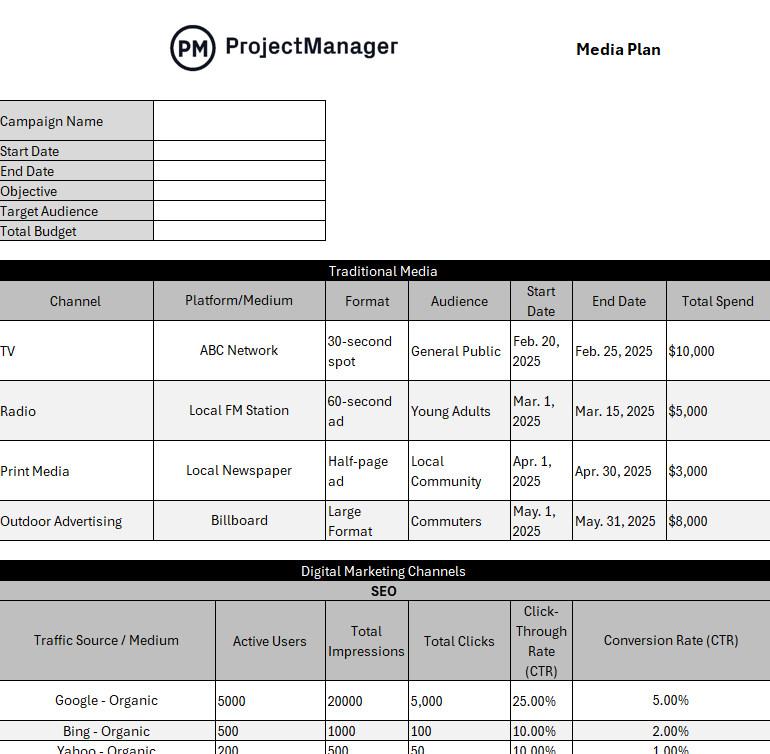
Why Should You Use a Media Plan Template?
Using a media plan template is crucial for several reasons, as it helps businesses streamline their advertising efforts and achieve marketing goals more efficiently. It maximizes budget efficiency by allocating advertising budget strategically across the most effective channels. This ensures that every dollar spent delivers the best possible return.
A media plan template ensures the message is delivered to the right audience. By identifying the target market and selecting the right media channels (TV, digital, social media, etc.), it’s easier to reach people who are more likely to engage with your brand.
A well-structured media plan template ensures that ads run at optimal times to capture the audience’s attention. It also helps determine the ad frequency—ensuring the audience isn’t overexposed (which can lead to ad fatigue) or underexposed (which can reduce effectiveness).
It provides a clear roadmap for executing a campaign. A media plan template outlines what will be done, when it will be done and how much will be spent. This clarity helps avoid miscommunication or confusion between the marketing team and other stakeholders.
By setting KPIs and tracking performance, a media plan template helps measure the campaign’s success. If certain channels or tactics are underperforming, adjustments can be made in real time. This also helps align the campaign with business goals.
However, a media plan template is a static document set up to manage a dynamic plan. Rather than depend on a template that must be constantly updated and is poor for collaboration, media professionals should upgrade to project management software.
ProjectManager is award-winning project and portfolio management software that has robust roadmaps to plan, manage and track multiple media campaigns all in one place. The roadmap provides a Gantt chart-like view, allowing marketing teams to visualize their media plan timeline, including project phases, tasks and milestones.
The plan can be broken down into phases, with priority, estimated costs, status and deliverables easily tracked. Assignments of specific team members and nonhuman resources can be managed, including balancing workload. Link all four types of task dependencies to avoid delays and cost overruns. Plus, set a baseline to track actual progress against the plan in real time. Get started with ProjectManager today for free.
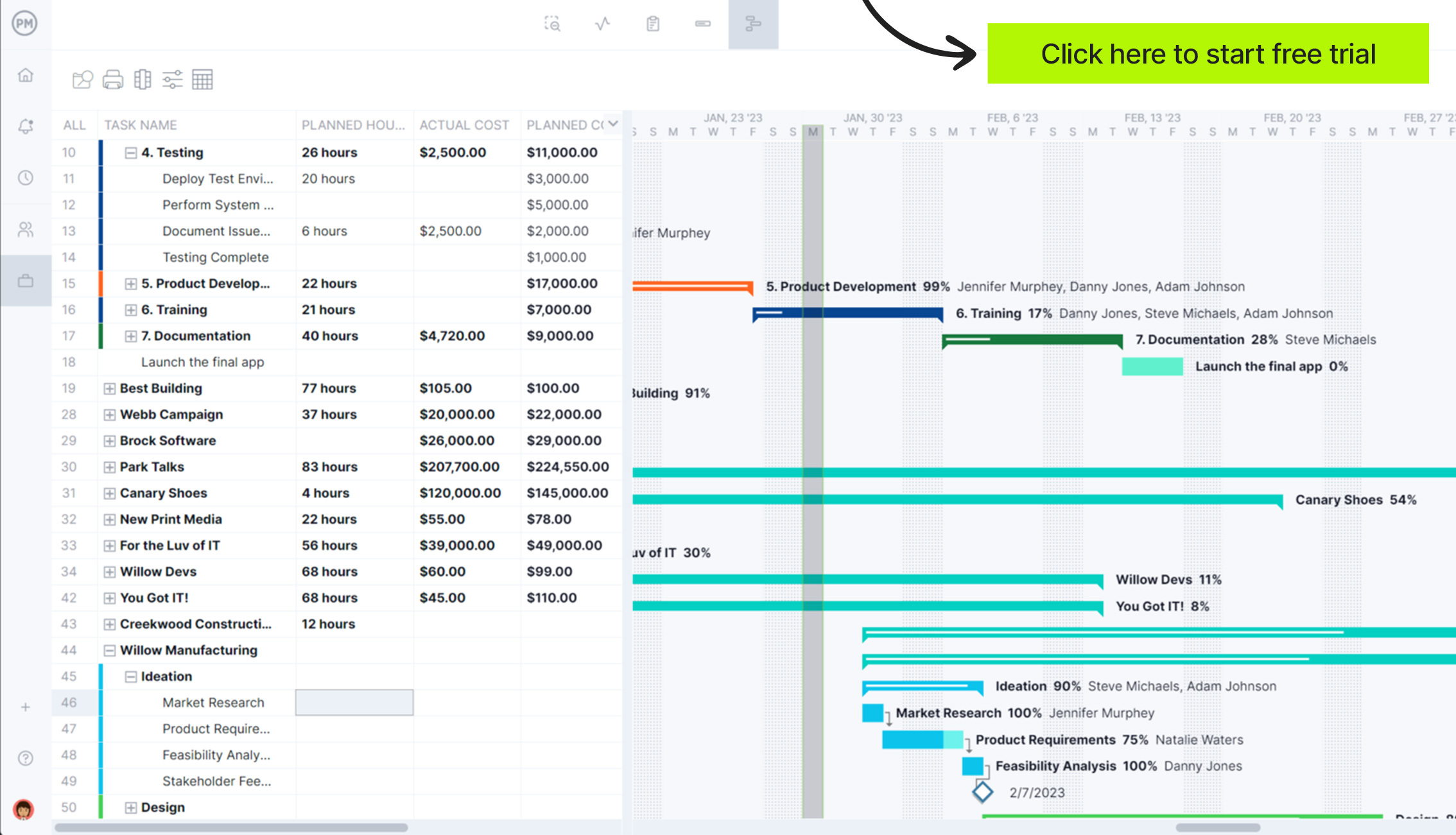
When to Use a Media Plan Template
Use this free media plan template when in the following situations.
- When launching a new advertising campaign
- When you have a defined marketing goal
- When you have a specific target audience
- When budget allocation needs to be managed carefully
- When managing a multi-channel marketing plan
- When timing and frequency are important
- When evaluating past campaign performance
- When you need to adjust campaign strategy mid-course
- When your business is scaling or expanding
- When coordinating multiple teams or stakeholders
- When preparing for a long-term campaign
Who Should Use this Media Plan Template?
A media plan template is valuable for various roles and teams involved in marketing, advertising and business strategy. Here’s who should use it.
- Marketing managers and directors
- Advertising agencies and media buyers
- Brand managers
- Social media managers
- Content strategists
- Product managers
- Small business owners
- Marketing analysts
- Public relations teams
- Event planners and coordinators
- Nonprofit organizations
- Chief marketing officers
- Influencer marketing managers
- Sales teams
How to Use This Media Plan Template for Excel
Download this free media plan template and open a fully customizable document. We’ve broken it into three sheets: the media plan, budget breakdown and results and metrics. Users can add or remove content as they see fit to match their campaign. Here’s what we’ve included.
Components of a Media Plan
This is a brief definition of the key media plan components for traditional media.
- Channel: The type of media used, such as TV, radio, print (newspapers/magazines) or outdoor advertising (billboards, transit ads).
- Platform/Medium: The specific outlet or provider within the chosen channel, such as a particular TV network (e.g., ABC), radio station (e.g., NPR) or print publication (e.g., The New York Times).
- Format: The type of advertisement or content used within the platform, such as a 30-second TV commercial or a full-page magazine ad.
- Audience: The specific demographic or group the campaign is targeting (e.g., age, gender, location, income level, interests). In traditional media, this often includes details like geographic reach and viewer/listener profile.
- Start Date: When the advertising campaign begins and the first ads start running.
- End Date: When the campaign finishes and the last ads are aired or published.
- Total Spend: The total budget allocated to the campaign for the specific media (e.g., total cost of purchasing TV airtime or radio spots).
Here’s a brief definition of the key media plan components for digital media like SEO, SEM, email marketing and social media:
SEO (Search Engine Optimization)
- Traffic source/medium: The channel from which visitors visit a website (e.g., organic search from Google).
- Active users: The number of unique users engaging with your website.
- Total impressions: The number of times a website appears in search results.
- Total clicks: The number of times users click on a website from search results.
- Click-through rate (CTR): The percentage of impressions that resulted in a click (Total clicks ÷ Total impressions).
- Conversion rate: The percentage of visitors who take a desired action (e.g., make a purchase, sign up).
SEM (Search Engine Marketing)
- Traffic source: The source of paid traffic from search engines (e.g., Google Ads, Bing Ads).
- Total impressions: The number of times an ad is shown to users.
- Total clicks: The number of times users click on a paid ad.
- Click-through rate (CTR): The percentage of impressions that resulted in a click (Total clicks ÷ Total impressions).
- Cost per click (CPC): The amount you pay each time someone clicks on your ad.
- Cost per acquisition (CPA): The cost of acquiring one customer (Total cost ÷ Number of conversions).
- Return on ad spend (ROAS): The revenue generated for every dollar spent on ads (Revenue ÷ Ad spend).
Email Marketing
- Email campaign: A series of emails sent to a targeted list with a specific objective (e.g., product promotion, newsletters).
- Open rate: The percentage of recipients who open the email (Total opens ÷ Total delivered).
- Click-through rate (CTR): The percentage of recipients who clicked on a link within the email (Total clicks ÷ Total opens).
- Unsubscribe rate: The percentage of recipients who opt out of receiving future emails (Total unsubscribes ÷ Total delivered).
- Spam rate: The percentage of emails marked as spam by recipients (Total spam reports ÷ Total delivered).
- Revenue per email: The amount of revenue generated for every email sent (Revenue ÷ Total emails sent).
- Forward email rate: The percentage of recipients who forward the email to others (Total forwards ÷ Total delivered).
Social Media
- Traffic source: The platform or network from which traffic is driven (e.g., Facebook, Instagram, Twitter).
- Total impressions: The number of times a social media post/ad appears on users’ screens.
- Click-through rate (CTR): The percentage of impressions that result in a click on the link (Total clicks ÷ Total impressions).
- Cost per click (CPC): The amount paid for each click on a social media ad.
- Follower growth rate: The rate at which social media followers increase over a specific period.
- Conversion rate: The percentage of users who take a desired action after interacting with a social media post or ad (e.g., purchase, sign-up).
- Engagement: The level of interaction with your posts, including likes, shares, comments and reactions. This shows how well content resonates with the audience.
More Free Templates to Help With Media Planning
A media plan template paints the larger picture, but for those who want to delve into those details, we offer over 100 free project management templates for Excel and Word that address every stage of a project across multiple industries. Below are just a few that can help with media planning.
Marketing Budget Template
The budget breakdown is part of the media plan template, but it’s not as detailed as marketing managers will need when creating a budget. This free marketing budget template for Excel looks at long-term spending over the quarters of the year and how each category is spending that budget.
Marketing Calendar Template
Use this free marketing calendar template for Excel to further your media plan template. It is a great tool for keeping a team aligned. All the work is visible and the tasks are delegated so everyone knows what they’re working on and when they need to have that work completed by.
Marketing Campaign Template
A marketing campaign helps to decide on campaign goals, targeting, media plan and execution. Use this free marketing campaign template similarly to as one would use the media plan template, only it opens in ProjectManager and has all the advantages of our software.
ProjectManager Can Manage Your Media Campaign
Templates are fine but only to a point. Once that point is reached, templates can become frustrating because these are static documents that require manual updates that detract from more important work. They’re always behind in displaying data and aren’t great at collaborating with teams, especially across departments.
For those who want to connect their cross-functional teams and have real-time data to make more insightful decisions, we recommend upgrading to project management software. ProjectManager is award-winning project and portfolio management software with multiple project views that let everyone work on the tools they prefer with real-time tracking to ensure that deadlines are met and budgets aren’t exceeded.
Use Multiple Project Views
A media plan can be made of several campaigns or projects, and the roadmap is a great tool to schedule, manage and track them all in one place. But it’s not great for executing that work. While it can link dependencies, filter for the critical path and set a baseline to track variance in real time, various departments tasked with delivering assets in the campaign won’t need those tools.
However, the plan created on the roadmap or Gantt charts is shared throughout the software. That means the visual workflow of a kanban can help media planning departments, while task lists are great for those responsible for website maintenance, content projects, creating advertising artwork, etc. The calendar view is a great tool for stakeholders to stay updated on progress.
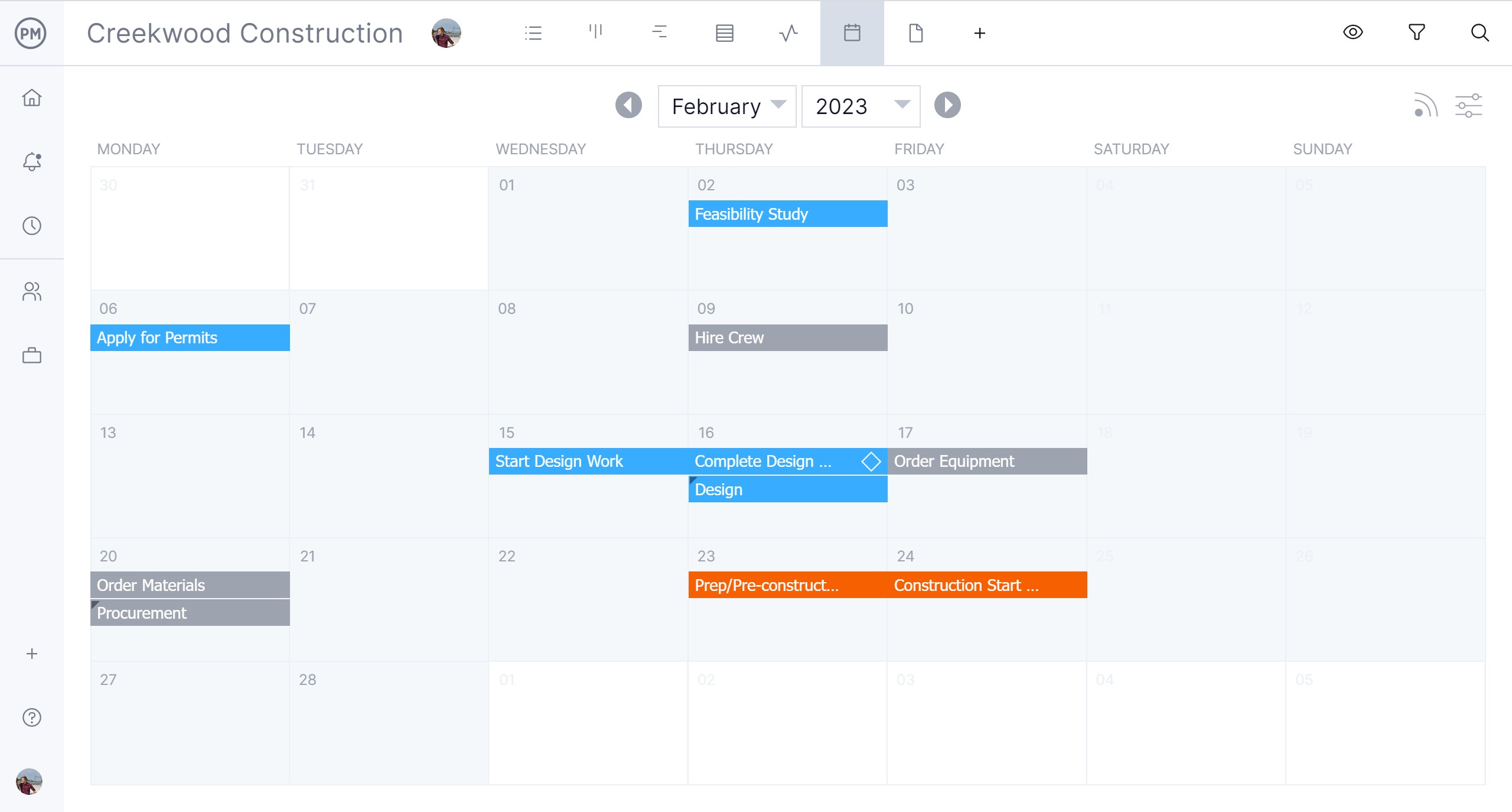
Monitor Progress With Real-Time Dashboards
Media managers can track progress and meet deliverable deadlines with several features. For a high-level overview, there are real-time project or portfolio dashboards to track individual or multiple projects in one place. Easy-to-read graphs and charts track key metrics, such as time, cost and workload. Customizable reports go deeper into the data with reports on status, portfolio status, variance, workload, timesheets and more. Each report can be filtered to focus on specific data points or provide a summary to share with stakeholders. Secure timesheets streamline payroll but also monitor labor costs to keep campaigns on budget.
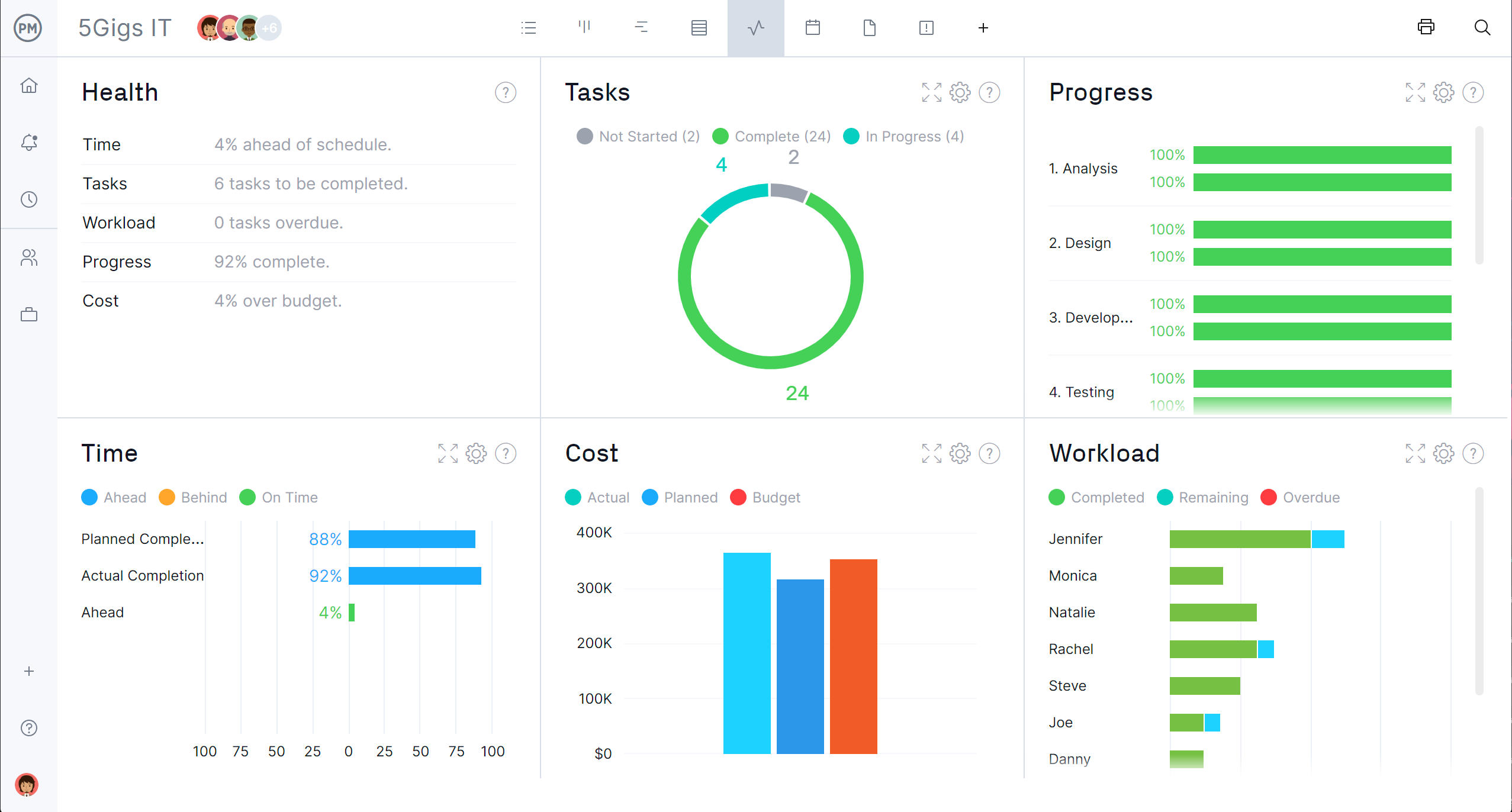
Related Marketing Content
A media plan template is part of the larger marketing initiative. For those who want to read more about this topic, you’ve come to the right place. We publish several blogs a week on project management and how it relates to a variety of industries. Below are some of the recent posts we’ve made on marketing.
- How to Create a Marketing Budget: A Quick Guide
- How to Implement Your Marketing Plan
- What Is a Marketing Plan & How Do I Make One?
- Marketing Calendar Template for Excel (Free Download)
- Marketing Budget Template for Excel (Free Download)
ProjectManager is online project and portfolio management software that connects teams whether they’re in the office or out in the field. They can share files, comment at the task level and stay updated with email and in-app notifications. Join teams at Avis, Nestle and Siemens who use our software to deliver successful projects. Get started with ProjectManager today for free.
